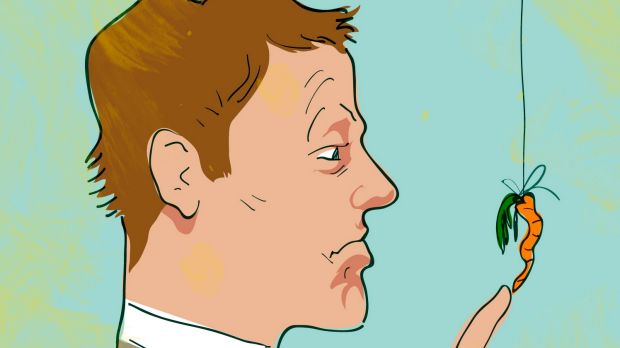Something quite odd is happening to the pay-packets of Australian workers.
Wages, not including bonuses, rose just 1.9 per cent over the year ended the March quarter.
More BusinessDay Videos
No chance wages will suddenly pick up
The economics text book on wages is wrong; there are a number of reasons why wages growth will remain subdued. Michael Pascoe comments.
Over the same period, the cost of purchasing the typical basket of consumer goods and services went up 2.1 per cent, in part due to a surge in petrol prices.
So, after shelling out more at the shops, Aussie workers didn't get a pay rise to match those higher costs.

Wages actually shrank in real terms, that is, after adjusting for inflation.
That is unusual, indeed. And it does not bode well for a consumer-led economic recovery.
But it is not unprecedented.
Annual wages growth has failed to keep pace with consumer price inflation in 13 out of the 75 quarters since the middle of 1998, when the Bureau of Statistics began its Wage Price Index survey.

In 2000, the introduction of the GST caused a spike in annual inflation to around 6 per cent. Wages did not keep pace, growing just 3 per cent, although households were also given tax cuts and pension increases.
By the time the investment bank Lehman Brothers collapsed in September 2008, bringing the global financial crisis to Australia, inflation had again roared ahead of wages growth, thanks to the inflationary pressures created by the mining boom. Then Treasurer, Wayne Swan, famously declared the "inflation genie" out of the bottle.
Wages growth peaked at 4.3 per cent at the end of 2008, while inflation peaked at 5 per cent. A year later, with the ravages of the global financial crisis beginning to be felt in lower commodity prices, inflation had fallen swiftly to just 1.2 per cent.
Since then, it's been a race to the bottom for both wages and prices growth.
In late 2013 and early 2014, wages again dipped below inflation. And here we are again.
"Wage growth remains slow and this is likely to remain the case for a while yet," the Reserve Bank governor, Phillip Lowe, wrote in a statement released after the last Reserve board meeting on May 2.
In its quarterly statement on monetary policy released later that week, the RBA expanded: "Although it seems unlikely that wage growth will slow much further, wage pressures are expected to pick up only gradually, as the effects of structural adjustment after the mining investment boom – which have weighed on wage growth – continue to wane."
The Reserve is tipping the jobless rate to fall, but remain above full capacity, leaving slack in the labour market which will constrain wages.
Even so, something odd appears to be happening: "In addition, wage outcomes have been weaker than would be suggested by a straightforward assessment of spare capacity based on the unemployment rate."
Quite clearly, the Reserve Bank is perplexed by low wages growth.
In an article titled "Insights into low wage growth in Australia" released in March, two bank researchers James Bishop and Natasha Cassidy, were given the task of explaining the surprisingly poor wages performance.
"Recent low wage growth in Australia appears to be only partly explained by spare capacity in the labour market, the decline in inflation outcomes and the decline in the terms of trade from its 2011 peak."
Something else, they argue, must be going on. What exactly that is, however, remains unclear.
The rise in underemployment is part of the explanation. Much of the recent jobs growth has been in part-time employment. While this suits the preferences of many workers, like second-income earners and students, many would prefer to work more hours – adding a degree of "hidden" supply to the labour market, which may restrain wage increases.
The story may run deeper, the researchers note, pointing to international research speculating low wages growth is due to a global decline in worker bargaining power.
"For example, new arrangements, such as a restructuring of work processes due to technological progress, an increase in contract work, and increased competitive pressure from growing internationalisation of services trade, may be weighing on wage growth. These factors, alongside spare capacity in the labour market, may be making workers feel less secure about their jobs and, in turn, they may be less inclined to push for larger wage increases."
Whatever the cause, the weakness in wages has clearly blind-sided policymakers.
In a stunning graph in their research article, the two authors reveal the extent to which the Reserve Bank has got it wrong with its forecasts for a pick-up in wages growth. For every forecast since 2011, wages growth has undershot the two-year forecast, usually by about a full percentage point.
The Reserve Bank does not publish a precise forecast for wages growth, but the graph in the research article suggests that as of February, the Reserve was predicting annual wages growth of a little above 2.5 per cent by the end of 2019.
Treasury is banking on an even bigger pick-up in wages to deliver the income-tax revenue growth needed to get back into surplus.
It forecasts wages to grow 2 per cent this financial year, rising to 2.5 per cent in the coming financial year and 3 per cent in 2018-19. It further projects wages to rise by 3.5 per cent in 2019-20 and 3.75 per cent in 2020-21.
Every pundit is convinced Treasury is being too optimistic.
Mostly, they have fallen into the trap of mistaking "projections" for "forecasts". Treasury only builds bottom-up forecasts for the first two financial years of the budget's two-year horizon. The final two years, predicting 3 per cent plus wages growth, are simply "projections", based on historical averages. You've got to plug some number into your four-year model, but Treasury has never pretended these are "forecasts".
And, at some point, it is reasonable to expect that wages will turn.
Over the long term, wages must rise to compensate workers for the higher cost of living and to provide them their share of the gains of rising productivity.
At a time of low inflation and low productivity, wage gains are less important.
Eventually, however, economic cycles turn.
In Australia, the drag from the end of the mining boom is almost at an end. Households with mortgages are feeling the benefits of record low interest rates and rising home values. An ageing population is leading to rapid growth in health services. Indeed, wages growth in the education and health sectors has been strong, underpinned by robust jobs creation.
More rapid wages growth won't happen over night. But it will happen.















